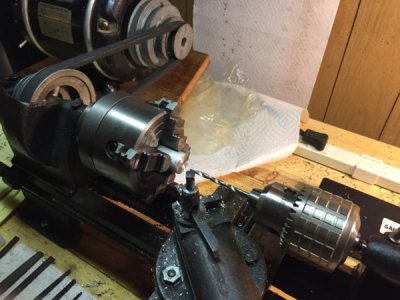- Joined
- Aug 8, 2017
- Messages
- 17
With high hopes for actually making something useful, I've gotten my first few tools installed on my AA109. When I got this lathe last month (http://www.hobby-machinist.com/threads/my-first-lathe-dont-laugh.61605/) it didn't come with much.
I managed to get a 3" chuck mounted on the 1/2"-24 spindle, and I got a 1/2" drill chuck on a MT0/J33 arbor. They look comically large on this delicate little lathe.

Facing operations close to the chuck seem to go well. Drilling is .. possible (more on that below).
For the chuck, I found a backplate with the right bolt pattern, but I had to turn down the "locater" step on the front of it. Without a way to slow down the motor much, this proved impossible with HSS tools, so I had to buy a set of brazed carbide tools. It came with C6 and C2 grade tools. I used the C2 and it managed to cut the cast iron backplate, but I'm still not clear on the difference. C6 is slightly softer and is meant for steel?
I can get 0.005" runout on the chuck. There isn't much rigidity in any part of this system. Just leaning on the workbench moves the spindle a few thousandths. When it's actually under power, the runout is probably much worse.
The runout on the drill chuck is really terrible. As I turn the tailstock spindle, the tip of the drill (pictured above) will inscribe a 1/16" diameter circle! There's slop in the tailstock itself, and I'm not sure the arbor is a great fit (I read something about these lathes not quite matching a MT0 taper). But, probably I just don't know how to align these parts? I hope it's me and not the tool.
When the drill bit gets about 3/4" deep into a cut it starts to get resistance. If I continue it feels unsafe, like the motor wants to spin the tailstock backwards against me. Maybe the drill will have less runout if I engage more of the tailstock spindle threads? The full travel of the tailstock is about 1.5". I'm not sure what to do. Your help is much appreciated!
I managed to get a 3" chuck mounted on the 1/2"-24 spindle, and I got a 1/2" drill chuck on a MT0/J33 arbor. They look comically large on this delicate little lathe.

Facing operations close to the chuck seem to go well. Drilling is .. possible (more on that below).
For the chuck, I found a backplate with the right bolt pattern, but I had to turn down the "locater" step on the front of it. Without a way to slow down the motor much, this proved impossible with HSS tools, so I had to buy a set of brazed carbide tools. It came with C6 and C2 grade tools. I used the C2 and it managed to cut the cast iron backplate, but I'm still not clear on the difference. C6 is slightly softer and is meant for steel?
I can get 0.005" runout on the chuck. There isn't much rigidity in any part of this system. Just leaning on the workbench moves the spindle a few thousandths. When it's actually under power, the runout is probably much worse.
The runout on the drill chuck is really terrible. As I turn the tailstock spindle, the tip of the drill (pictured above) will inscribe a 1/16" diameter circle! There's slop in the tailstock itself, and I'm not sure the arbor is a great fit (I read something about these lathes not quite matching a MT0 taper). But, probably I just don't know how to align these parts? I hope it's me and not the tool.
When the drill bit gets about 3/4" deep into a cut it starts to get resistance. If I continue it feels unsafe, like the motor wants to spin the tailstock backwards against me. Maybe the drill will have less runout if I engage more of the tailstock spindle threads? The full travel of the tailstock is about 1.5". I'm not sure what to do. Your help is much appreciated!
